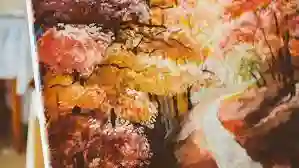
The Influence of Music: Translating Sound into Visuals in Oils
The connection between music and visual art has been a source of inspiration for artists throughout history. Music’s ability to evoke emotions, convey narratives, and create atmosphere has led many painters to explore the idea of translating sound into visuals. In the world of oil painting, this intriguing concept opens up a realm of creativity where artists can harness the power of music to inform their artistic process and produce visually captivating works. In this article, we will delve into the influence of music on oil painting, exploring how artists use sound as a catalyst for their visual expressions.
The Symbiotic Relationship Between Music and Art
The relationship between music and visual art is deeply rooted in human creativity. Both art forms share common elements such as rhythm, harmony, balance, and emotion. Many artists have recognized this connection and sought to integrate music into their visual expressions.
The symbiotic relationship between music and art is evident in various ways:
- Synesthesia: Some artists experience synesthesia, a neurological condition in which sensory perceptions are involuntarily intertwined. For synesthetes, music may trigger visual experiences, such as seeing colors, shapes, or patterns.
- Mood and Emotion: Music has the power to evoke specific moods and emotions. Similarly, visual art can convey feelings and atmospheres. When artists listen to music while painting, they may channel the emotional energy of the music into their artwork.
- Narrative and Storytelling: Both music and visual art can tell stories. Composers create musical narratives, while painters craft visual narratives. These narratives can intersect, with one art form inspiring or complementing the other.
How Music Influences the Creative Process
Artists often use music as a source of inspiration and motivation during their creative process. Here’s how music can influence the various stages of oil painting:
- Inspiration: Music can serve as a catalyst for generating ideas and themes for a painting. A particular song or genre of music may evoke imagery, memories, or emotions that spark an artist’s imagination.
- Mood Setting: Different types of music can set the tone for the painting process. Upbeat, energetic music may be used to infuse energy and movement into a piece, while calm, soothing music can create a serene atmosphere for more contemplative works.
- Flow and Rhythm: Just as music has rhythm, oil painting has its own rhythm and flow. Artists may synchronize their brushwork with the tempo and rhythm of the music, creating a harmonious dance between sound and visual expression.
- Emotional Connection: Artists often choose music that resonates emotionally with the theme or message of their artwork. The music can help them tap into the desired emotional state, infusing their work with depth and authenticity.
Musical Genres and Visual Styles
Different musical genres can lead to a wide range of visual styles in oil painting. Here are a few examples of how music genres can influence the visual outcome:
- Classical Music: The elegance and sophistication of classical compositions may inspire artists to create detailed and refined oil paintings. The harmonious compositions of classical music can translate into balanced and harmonious visual compositions.
- Jazz: The improvisational nature of jazz music can lead to abstract and spontaneous oil paintings. Jazz’s sense of freedom and experimentation may encourage artists to take risks with color, form, and texture.
- Rock and Roll: The energy and dynamism of rock and roll music can result in bold and expressive oil paintings. Artists may use bold brushwork, vibrant colors, and dramatic contrasts to capture the essence of this genre.
- Electronic and Ambient Music: Ambient and electronic music’s ethereal and atmospheric qualities can inspire artists to create dreamlike and surreal oil paintings. The blending of colors and the sense of fluidity can mimic the abstract nature of this music.
Case Studies: Artists Inspired by Music
Several renowned artists have been deeply influenced by music in their oil painting practices:
- Wassily Kandinsky: Kandinsky, a pioneer of abstract art, believed that music and visual art shared a spiritual connection. He often listened to music while painting and sought to convey the emotions and rhythms of music through his abstract compositions.
- Georgia O’Keeffe: O’Keeffe was known for her iconic paintings of flowers, landscapes, and abstractions. She often listened to music, including the music of her husband, Alfred Stieglitz, while working on her art. Music helped her find inspiration and connect with the natural world.
- Jackson Pollock: Pollock, a pioneer of abstract expressionism, was known for his energetic and chaotic drip paintings. He once stated that he painted to the rhythm of his own heartbeat and the music he listened to, creating a visceral connection between sound and motion in his work.
Conclusion:
The influence of music on oil painting is a testament to the harmonious fusion of two expressive art forms. Artists who explore this connection find that music can be a powerful muse, guiding their creative process and infusing their works with emotion, rhythm, and narrative. The translation of sound into visuals in oil painting offers a rich and captivating avenue for artists to explore, resulting in artworks that resonate on both visual and auditory levels. As artists continue to embrace the influence of music, the boundaries between the senses of hearing and sight blur, creating a dynamic and immersive experience for both creators and viewers of art.